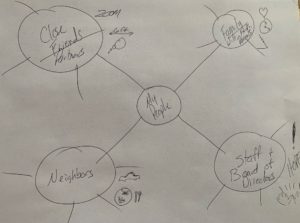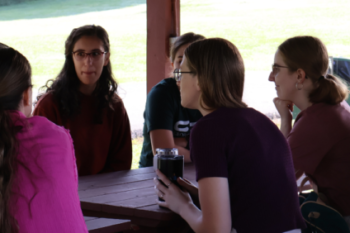Three Questions that Changed My Approach to Leadership
One month into the COVID pandemic, I experienced leadership paralysis.
It was not just that the operations of our ministry had to be relocated to digital forms – as a college ministry who works with digital natives, we were well positioned and nimble enough in our structure to make that move well.
The paralysis I felt was an overload of my leadership response system.
As a parent of a then graduating senior and two college students whose lives and dreams had suddenly been turned upside down; I was continually asking myself, “How do I help my own family navigate the anxiety of an uncertain future?” As a neighbor in my community and follower of Jesus; I became acutely aware of the needs of my neighbors and overwhelmed with the exposure of the vulnerability of populations in our community. What can I do, what should I do, what is my own level of risk? As our nation and our church partners grew more and more entrenched in political division, I was being asked to respond to the divisiveness in the church at large, to use my voice in places other voices won’t be heard (or listened to). I was being asked to handle all this while feeling an overwhelming responsibility to our team of 19 people with their own challenges. The list could go on.
If you are a leader, then you know the feeling you get when you are sitting in a situation where there is a leadership void. It’s as if the laws of nature themselves are compelling you to fill the void (and you will). We can do this in short spurts. We can empty the reserves. But, when our leadership response system is on high alert for weeks that turn to months, there is a danger of displacing our leadership resources without return.
So, I did something that busy and overwhelmed ministry leaders don’t often like to do: I prayed. As I prayer journaled, I felt God prompt me to open a clean page in my journal and listen. As I did, three questions immediately came to my mind. And those three questions changed my leadership then, and continue to shape the stewardship of leadership now.
The 3 questions were:
- Who are MY people?
- What do they need from me (that they can’t get from someone else)?
- How do I get it to them?
So, I began to mind map these three questions:
- Who are my people?
If you have never experimented with mind-mapping, the basic idea is to put the main topic/theme in the middle of a page, linking sub-concepts to the main idea through lines, words and pictures (I recreated mine below).
My list began with my immediate family (wife, children and parents). Then I added a bubble for my staff and board of directors, finally, I added bubbles for my physical neighbors and close friends. Within each bubble, I listed the names of specific people. My initial list was probably 60 people. But, the next two questions were both humbling and clarifying as a leader.
The second question:
- What do they need from me that they cannot get from someone else?
At first I simply wrote the question, “What do they need from me?” That quickly changed as I began to map out what I thought people needed. I had thought part of my job as a leader was to anticipate the needs of the organization and be ready to meet the need. How could I possibly know what all of these people actually need right now?
This was the clarifying moment: I asked.
I simply called them, sat down with them (when possible), or zoomed with them and directly asked the question, “What do you need from me right now?”
This was also the humbling moment for me in stewarding leadership: it turned out that some of the people I thought were “my people” were not my people!
I called one ministry partner and he responded, “I don’t think there is anything I need from you right now, but I guess you can pray for me.” I’m not against praying, but it was clear this was an afterthought: an answer to give me something to do, not an unmet need or a need my specific skillset could fill.
That prompted the expanded question, “What do you need from me that you cannot get from someone else?”
This changed the conversations entirely.
No one else can be my children’s father. No one else can be my wife’s husband. No one else can be the director of our organization. No one else can be the next door neighbor to Barbara. No one else could be me in our golf foursome. I didn’t realize until that moment, but I was leaking leadership energy in places where it wasn’t needed. This revelation allowed me to fully and completely discern who God had called me alongside and to give my best to that calling.
This was such a beautiful time of love, care and conversation. I learned things I never knew and found ways to care for people that I would have never thought of by simply and directly asking that question, “What do you need from me right now?”
But there was still one more question to map:
- How do I get it to them?
When I asked the second question, “What do you need from me?, one of my staff responded to the question with, “I just need you to keep believing in what we’re doing.” One of my children said, “I need something that feels normal.” A ministry partner said, “Teach me how you guys are reaching students digitally so I can help students here.”
Suddenly, leadership paralysis had transformed into daily informed, directed, executable, and impactful action.
At home, my son and I built an outdoor rock climbing wall in our small urban yard to do something he would normally do but couldn’t (stimulus money at work). As the director of our organization, I began to send video messages of encouragement to staff, enthusiastically applauding new ideas (even if they failed), and shared how I was seeing God at work in their lives and ministry. We also began hosting a Zoom workshop for ministry partners to learn about our outreach and discipleship model.
None of these things would have happened had I not been intentional about asking those three questions: Who are my people? What do they need from me that they cannot get from someone else? How do I get it to them? This mind-mapping exercise, part of my monthly journaling and reflection routine, has dramatically changed my leadership style for the better.






